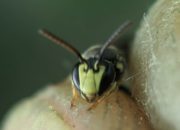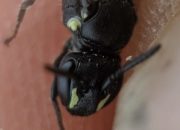Masked Bees are tiny black and yellow bees found statewide from the spring through early fall. They have very few hairs and carry their pollen internally, making them appear more like wasps than other bee genera.
As of January 2021, 10 species in the genus Hylaeus have been recorded in Vermont, 5 of which have been confirmed through iNaturalist.
Genus level ID
Once you notice this genus, they can be easily found in a variety of habitats throughout the summer. Queen Anne’s Lace and other umbelliferous flowers are great places to find them. Almost all Masked Bees can easily be recognized by the solid black bodies with yellow joints and facial marks. The extent and shape of the yellow is important for species-level ID, though can be variable within and between species. Males and females are easily separated by the pattern of yellow on the face, and unlike many bee genera, males are generally easier to ID.
The vast majority of Masked Bees you are likely to encounter in the state belong the Modest Masked Bee (H. modestus) group. Females of this group are impossible to separate, even with the specimen in hand, and males can be quite variable, but some experts feel they can be reliably separated by the extent and pattern of yellow, with a yellow mark on the tegula indicating Eastern Masked Bee (H. affinis).
The four most distinctive Masked Bees are all quite rare and localized in VT. The two species with red abdomens (Nelumbo and Ornate) are wetland specialists known only from one site each on Lake Champlain. The Cinquefoil Masked Bee has thus far only been found in the heart of the Northeast Kingdom, though could occur in other cold pockets. It’s significantly larger than other species – with the females lacking yellow entirely and the males having bizarrely swollen antenna bases. The Slender-faced Masked Bee (Hylaeus leptocephalus) is likely an introduced species, and has distinctive white marks in place of the yellow, it has now been found in human dominated landscapes in several counties.
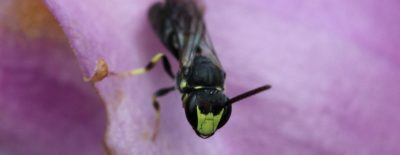
Modest Masked Bee group (Hylaeus modestus/H. affinis/H. illinoisensis)
Species in this group are the most abundant Masked Bees in the state, though are very tricky to separate from each other. Image courtesy Michael Veit.
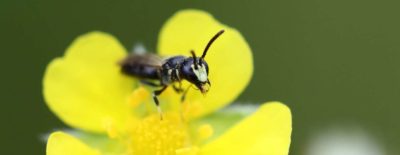
Mesilla Masked Bee (Hylaeus mesillae)
This is one of the smallest bees in VT, with some measuring only 3mm long. The upside side-down yellow raindrops around the base of the antenna of the males are distinctive. Image courtesy Michael Veit.
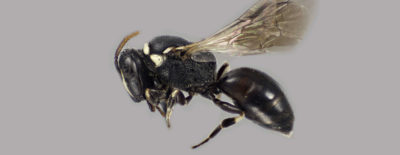
Slender-faced Masked Bee (Hylaeus leptocephalus)
This species has white marks instead of the typical yellow, which at the moment is unique among the species known from VT. Though its been in the US for more than a century, it is thought to have originated in Europe.
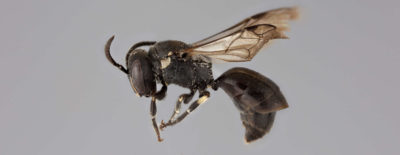
Annulate Masked Bee (Hylaeus annulatus)
A northern and mountain species. Females often, but not always, have a horizontal white mark across the bottom of their clypeus, which is unique.
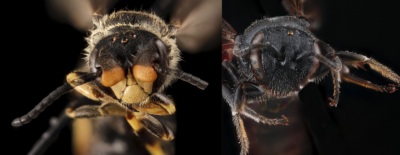
Cinquefoil Masked Bee (Hylaeus basalis)
This is a rare, but distinctive species. The few VT records are from the heart of the NEK, though there are scattered records through the Northeast and western Mountains.
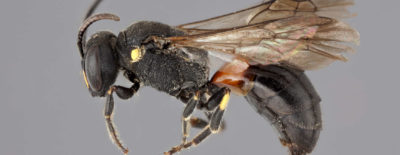
Nelumbo Masked Bee (Hylaeus nelumbonis)
One of two rare species with red on the upper segments of their abdomen. Only known from one marsh on Lake Champlain.
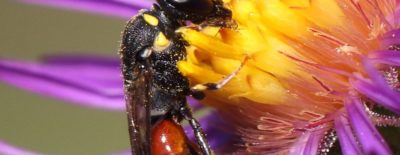
Ornate Masked Bee (Hylaeus ornatus)
One of two rare species with red on the upper segments of their abdomen. The VT records are all from one site near Lake Champlain, and represent a major range expansion for this primarily coastal and Great Lakes species.
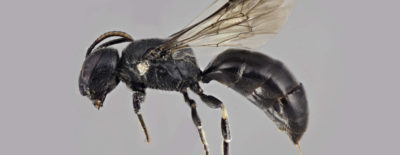
Broad-faced Masked Bee (Hylaeus sparsus)
This species is widespread in Eastern North America, but rarely collected anywhere. Two VT records from 2020. Females of this species have a distinctive spine at the base of there front legs that is probably impossible to photograph on a live bee.
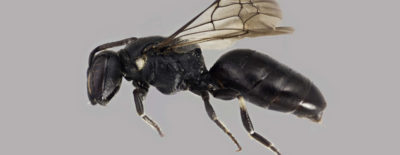
Vertical Masked Bee (Hylaeus verticalis)
Perhaps not recorded in VT in at least the past 50 years. Females have limited yellow marks, but this species is unlikely to be confirmed from photos.
Unless otherwise specified, photos in the grid are courtesy of Margarita Miklasevskaja at PCYU with funding from NSERC-CANPOLIN.
Please note that many of our datasets have not been published yet, so the maps are incomplete.
